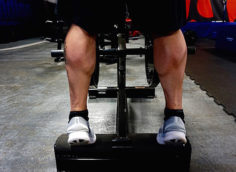The Sciency Approach vs. the Jazzy Approach
People generally fall into one of two camps when it comes to planning their workouts. One group, the more scientifically inclined, maps out everything in advance. They use largely the same big exercises but vary the intensity (sets and reps), all of which is laid out ahead of time in excruciating detail.
Lifters in this group carry gym bags that contain logbooks, calculators for figuring out percentages of 1RM, and probably a sextant and one of those things on a tripod that city workers use to survey land.
The other group of trainers is more jazz than science. They're more improvisational. Exercises are their instruments and they like to play a lot of them. They don't worry so much about intensity. They wear sunglasses and drink protein and scotch from their Nalgene bottles as they try to hit their groove on different machines or movements in smoky gyms.
Other people blend the two approaches, but it all begs the question: Which training style is best? The sciency, constant exercise and varied intensity approach, or the jazzy style where you use a lot of exercises?
Researchers from the University of Sao Paulo, the University of Tampa and Delboni Auriemo Diagnostic Imaging Sector did experiments to figure it out and they say that the "jazz" group has it right – that doing a variety of exercises is more important than changing loading schemes. Here's how they figured it out.
What They Did
The scientists split 49 recreationally trained males into 5 groups:
- Constant Intensity, Constant Exercise (CICE). This group did a "squat exercise" with 8RM (the most weight they could do for 8 reps).
- Constant Intensity, Varied Exercise (CIVE). This group did squats, deadlifts, lunges, and leg presses with their 8RM.
- Varied Intensity, Constant Exercise (VICE). This group did a squat exercise with 6-10RM.
- Varied Intensity, Varied Exercise (VIVE). This group did squats, deadlifts, lunges, and leg presses with 6-10RM.
- The control group.
The lifters trained twice a week for 12 weeks. All of them used equivalent amounts of volume. The scientists measured the cross-sectional area of each of their quad muscles with MRI, as well as their 1RM back squat, before and after the 12-week training block.
What They Found
The group that varied the exercise but not the intensity (CIVE) had the best results in overall quad size and strength while the group that varied intensity and varied exercise (VIVE) showed the least improvements.
Granted, all four protocols increased quadriceps size, but the CIVE group showed more complete muscle activation, growing all four heads of the muscle. The other methods didn't show as much development of the vastus medialis and the rectus femoris.
What This Means to You
If you're planning a leg workout (and maybe this applies to other muscle groups, too), you might do best to adopt a "jazzy" approach where you do a mixture of squatting, leg presses, deadlifts, and lunges with the same intensity (e.g., 8RM).
In other words, doing a variety of exercises – both unilateral and bilateral in a variety of planes – is more important to building muscles than doing the same exercise and just monkeying around with sets and reps.
Put into practice, that means maybe doing leg presses, lunges, leg extensions, and squats, etc., with the same number of reps per exercise instead of just doing squats (or bench presses) with varying set and rep schemes.
Of course, this experiment was done with guys who were active but weren't lifters, so there's a chance that grizzled old veteran lifters would have a different outcome.
Source
- Fonseca RM, Roschel H, Tricoli V, de Souza EO, Wilson JM, Laurentino GC, Aihara AY, de Souza Leão AR, Ugrinowitsch C. "Changes in exercises are more effective than in loading schemes to improve muscle strength," J Strength Cond Res. 2014 Nov;28(11):3085-92.





